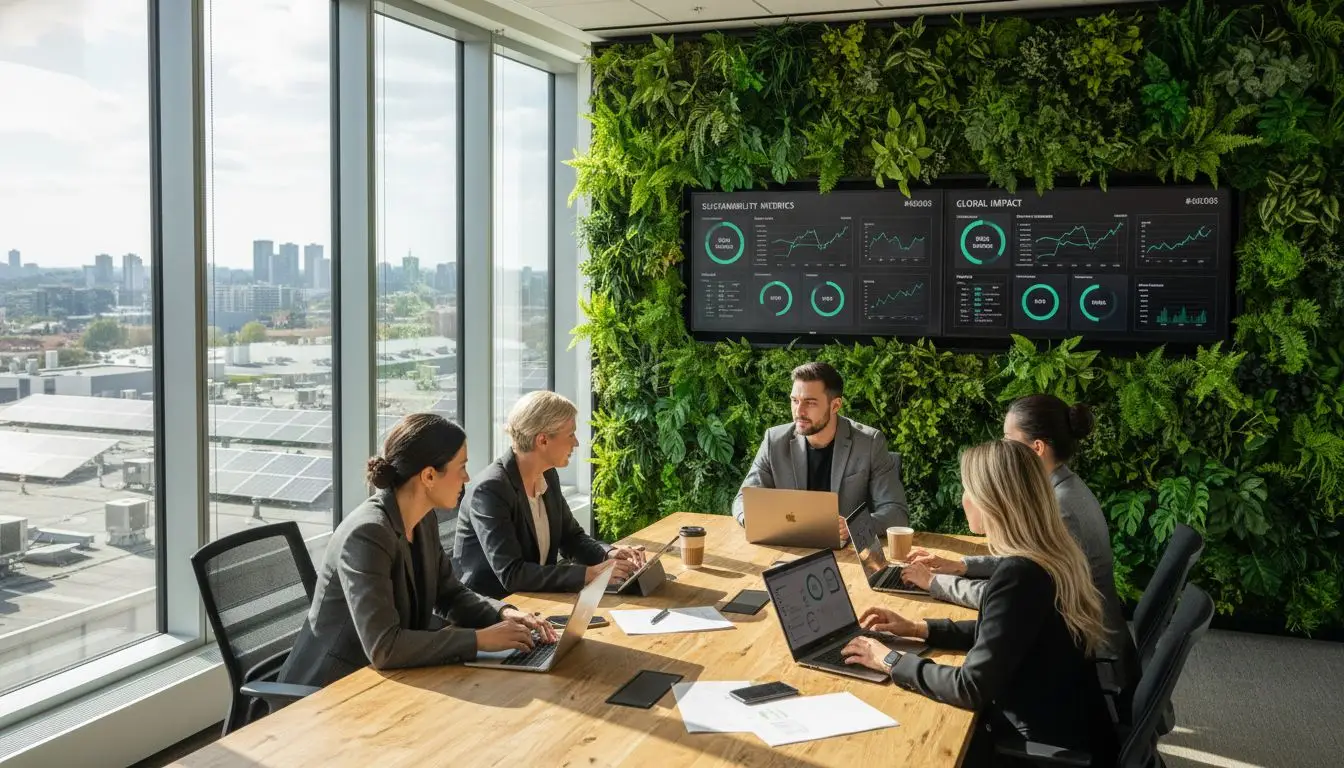Over 75 percent of global consumers now prefer to support environmentally responsible brands, making sustainable business no longer a fringe effort. Growing pressure to reduce pollution and energy waste has pushed companies to rethink every part of their operations. Today’s leaders are weaving sustainability into daily decision-making, discovering new opportunities for economic growth by minimizing their environmental impact while meeting rising expectations from customers, investors, and regulators.
Table of Contents
- Defining Green Business Initiatives And Core Concepts
- Types Of Green Practices In Business Operations
- Key Technologies And Sustainable Strategies Used
- Real-World Examples Across Industries
- Implementation Challenges And Success Factors
- Compliance, Costs, And Measuring Environmental Impact
Key Takeaways
| Point | Details |
|---|---|
| Integration of Sustainability | Green business initiatives transform traditional models by embedding environmental sustainability into core operations and strategies. |
| Holistic Approach Required | Successful green practices necessitate a comprehensive strategy that aligns all organizational functions with sustainability goals. |
| Emphasis on Technology and Innovation | Adoption of green technologies and eco-strategies is essential for enhancing operational efficiency and reducing environmental impact. |
| Measurement and Compliance | Businesses must develop strategies that integrate sustainability metrics into core processes for effective environmental impact management. |
Defining Green Business Initiatives and Core Concepts
Green business initiatives represent strategic approaches that integrate environmental sustainability into organizational operations, transforming traditional business models to minimize ecological impact while driving innovation and economic value. According to research from MDPI Sustainability Journal, green innovation involves developing products, services, processes, and business models that significantly reduce environmental harm while simultaneously creating economic and social benefits.
At its core, a sustainable business model describes how organizations create, deliver, and capture value through environmentally conscious strategies. As highlighted by research from ArXiv Sustainable Business Research, these models integrate environmental and social considerations directly into organizational core strategies. Key characteristics include:
- Minimizing resource consumption
- Reducing carbon emissions
- Implementing circular economy principles
- Prioritizing renewable energy sources
- Creating long-term ecological and economic value
Successful green business initiatives go beyond mere compliance. They represent fundamental reimaginings of how businesses operate, viewing environmental responsibility not as a constraint but as a strategic opportunity for innovation, efficiency, and competitive differentiation. Companies adopting these approaches demonstrate that ecological sustainability and business success are not mutually exclusive but can be powerfully interconnected.
Types of Green Practices in Business Operations
Green practices in business operations represent a comprehensive approach to integrating sustainability across multiple organizational functions. According to research from the International Institute of Engineers and Technology, these practices span several critical areas including green human resource management, green supply chain management, green innovation, sustainable manufacturing, and green logistics.
Sustainable operations techniques encompass a wide range of strategic approaches. As highlighted by Study Smarter Research, these techniques primarily focus on:
- Sustainable supply chain management
- Energy-efficient production processes
- Waste reduction strategies
- Utilization of eco-friendly materials
- Implementing circular economy principles
- Reducing carbon footprint across organizational systems
Successful green business practices require a holistic approach that integrates sustainability into every aspect of organizational operations. This means moving beyond isolated environmental initiatives to creating a comprehensive ecosystem of sustainable practices that align economic performance with ecological responsibility. By adopting these strategies, businesses can simultaneously reduce environmental impact, optimize resource utilization, and create long-term competitive advantages in an increasingly environmentally conscious marketplace.

Key Technologies and Sustainable Strategies Used
Green technologies are transforming how businesses approach environmental sustainability, integrating innovative solutions across multiple operational domains. According to research from MDPI Sustainability Journal, green innovation involves adopting technologies and strategies that systematically reduce environmental impact through renewable energy, energy-efficient processes, and sustainable product designs.
Eco-strategies represent a comprehensive approach to corporate sustainability. As highlighted by ArXiv Research, these strategies integrate Green IT and corporate social responsibility to enhance environmental performance and align business operations with sustainability goals. Key technological approaches include:
Here’s a summary of key green technologies and eco-strategies used by sustainable businesses:
| Technology/Strategy | Main Purpose | Example Application |
|---|---|---|
| Renewable energy | Reduce fossil fuel use | Solar panels, wind turbines |
| Energy management systems | Optimize energy consumption | Smart grids, BMS |
| Circular economy platforms | Enable resource recirculation | Materials marketplaces |
| AI-driven optimization | Boost process efficiency | Predictive maintenance |
| IoT sustainability tools | Monitor impacts in real time | Smart sensors, tracking |
| Cloud computing | Lower IT energy footprint | Virtual data centers |
- Renewable energy integration
- Advanced energy management systems
- Circular economy digital platforms
- AI-driven resource optimization
- IoT-enabled sustainability tracking
- Cloud computing for reduced energy consumption
Successful implementation of these technologies requires a holistic strategy that goes beyond simple technological adoption. Companies must create an integrated ecosystem where sustainability technologies work synergistically, transforming environmental responsibility from a compliance requirement to a core competitive advantage.
Sustainable IT Practices: Complete Guide for Enterprises provides deeper insights into how organizations can effectively leverage these innovative approaches to drive meaningful environmental and operational improvements.
Real-World Examples Across Industries
Ecopreneurship represents a transformative approach to sustainable business, where entrepreneurs deliberately create ventures that solve environmental challenges while generating economic value. According to Wikipedia’s Ecopreneurship Research, these innovative business models integrate environmental concerns directly into their core operational strategies, demonstrating how sustainability can drive entrepreneurial innovation.
One compelling manifestation of sustainable business practices is the concept of eco-industrial parks. As defined by Wikipedia, these are specialized industrial areas where businesses collaborate to minimize waste, reduce pollution, and efficiently share resources. Key characteristics of these collaborative ecosystems include:
- Shared infrastructure and utility systems
- Waste-to-resource exchange networks
- Collective environmental management
- Integrated energy and material flow optimization
- Collaborative sustainability goal setting
- Reduced collective environmental footprint
Industries ranging from manufacturing and technology to agriculture and energy are increasingly adopting these collaborative sustainability models. By viewing environmental responsibility as a collective opportunity rather than an individual burden, businesses can create systemic changes that generate substantial ecological and economic benefits. 7 Critical Sustainable Office Solutions for Modern Businesses offers additional insights into how organizations can implement these innovative approaches across different operational contexts.
Implementation Challenges and Success Factors
Sustainable entrepreneurship demands strategic navigation of complex environmental and operational challenges. According to research from ArXiv Climate Studies, effectively bridging climate awareness and business intentions requires a nuanced understanding of how sustainability campaigns influence organizational transformation.
Businesses encountering green initiative implementation face multiple critical challenges. As highlighted by ArXiv Business Research, addressing rising energy costs and environmental complexities necessitates a holistic approach. Key implementation obstacles include:
- High initial investment costs
- Technological adaptation requirements
- Organizational cultural resistance
- Complex regulatory compliance
- Limited expertise in sustainable technologies
- Measuring and quantifying environmental impact
- Balancing short-term economic constraints with long-term sustainability goals
Successful green business transformation requires more than technical solutions. Organizations must cultivate a comprehensive strategy that aligns technological innovation, workforce education, and strategic leadership commitment. By viewing sustainability as a strategic opportunity rather than a compliance burden, businesses can transform potential challenges into competitive advantages. Sustainable IT Practices: Complete Guide for Enterprises provides deeper insights into navigating these complex implementation landscapes.
Compliance, Costs, and Measuring Environmental Impact
Environmental compliance has evolved from a regulatory requirement to a strategic business opportunity. According to research from the International Institute of Engineers and Technology, implementing green practices can simultaneously achieve environmental standards compliance, generate cost savings, and enhance overall business competitiveness while contributing to the United Nations’ Sustainable Development Goals.
Green operations techniques provide a comprehensive framework for measuring and reducing environmental impact. As highlighted by Study Smarter Research, businesses can leverage sustainable strategies to optimize operational costs and minimize ecological footprints. Key measurement and compliance approaches include:
- Carbon emissions tracking
- Resource consumption analysis
- Waste reduction metrics
- Energy efficiency benchmarking
- Supply chain sustainability assessments
- Lifecycle impact evaluation
- Greenhouse gas protocol alignment
Successful environmental impact management requires more than data collection. Organizations must develop integrated strategies that transform compliance from a cost center into a value-generating mechanism. By embedding sustainability metrics into core business processes, companies can create transparent, measurable approaches to environmental responsibility. 7 Critical Sustainable Office Solutions for Modern Businesses offers practical insights into implementing these sophisticated measurement and compliance strategies.
Empower Your Green Business Initiatives with Smarter Document Workflows
Implementing green business initiatives described in the article demands more than environmental awareness. The challenges of reducing carbon footprints and optimizing resource consumption often tie directly to inefficient document handling and manual workflows. Businesses striving for sustainability need solutions that lower operational complexity and cut down on waste—both digital and physical. Terms like “workflow automation” and “resource optimization” from the article resonate strongly here, highlighting key areas where green practices and technology can intersect to achieve lasting impact.

Take action now to transform your environmental goals into measurable results by streamlining your document processes with Mapsoft’s specialized Adobe Acrobat® and PDF workflow tools. Explore how our PDF Hub API empowers you to automate large-scale PDF conversions, editing, and security features, reducing paper use and energy consumption. Learn more about integrating these sustainable operations by visiting Mapsoft.com. Don’t let document inefficiency slow your green transformation. Start optimizing today and lead the way in sustainable business innovation.
Frequently Asked Questions
What are green business initiatives?
Green business initiatives are strategies that integrate environmental sustainability into organizational operations, aiming to minimize ecological impact while driving economic value and innovation.
What are the key characteristics of a sustainable business model?
A sustainable business model focuses on minimizing resource consumption, reducing carbon emissions, implementing circular economy principles, prioritizing renewable energy sources, and creating long-term ecological and economic value.
How can businesses measure their environmental impact?
Businesses can measure their environmental impact using methods like carbon emissions tracking, resource consumption analysis, waste reduction metrics, energy efficiency benchmarking, and lifecycle impact evaluation.
What are some common challenges businesses face when implementing green initiatives?
Common challenges include high initial investment costs, technological adaptation requirements, organizational cultural resistance, complex regulatory compliance, and balancing short-term economic constraints with long-term sustainability goals.



